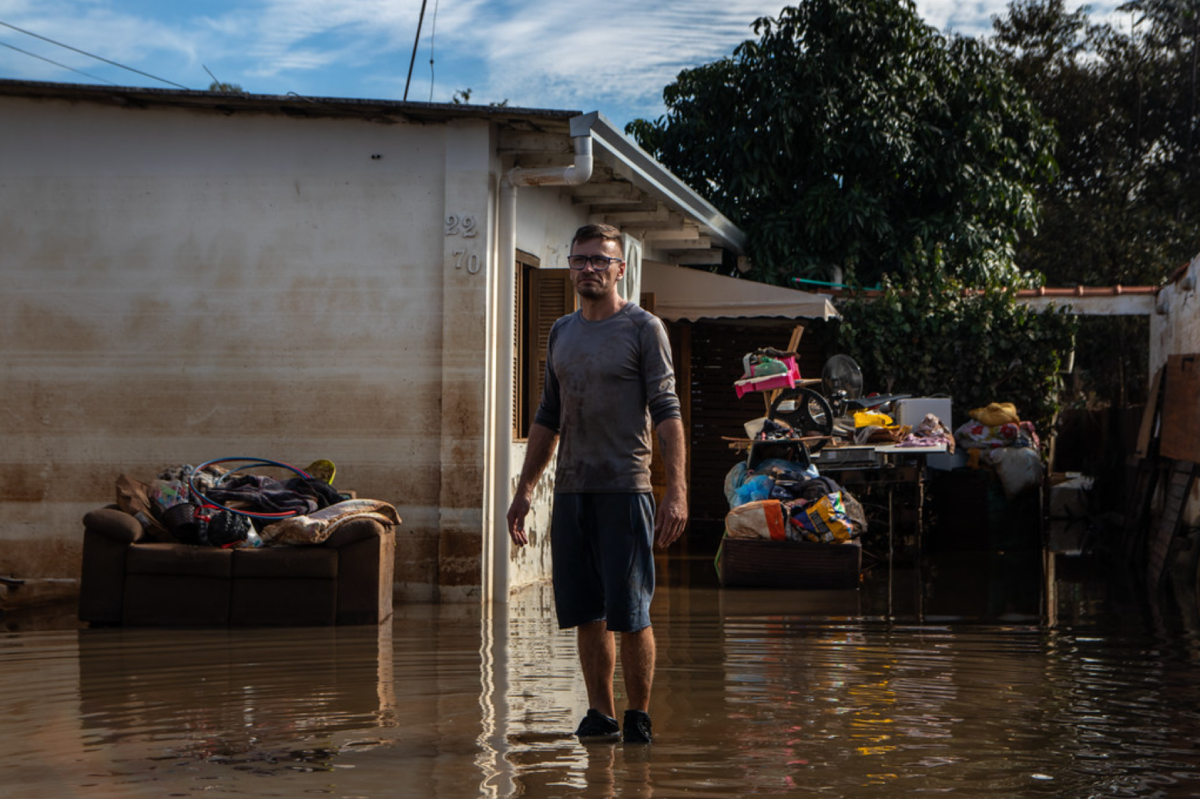It has to be said in no uncertain terms: the climate crisis in Rio Grande do Sul (RS) is already the biggest in Brazil’s history. It is already known that more than 460 municipalities are affected, representing more than 95% of the state’s municipalities, and some of them have had more than 70% of their populations affected. According to RS Civil Defense, there are more than two million people affected, of whom more than 600,000 have had to leave their homes. When we talk about municipalities and people affected, we are talking about flooded, destroyed cities and many areas that have already been evacuated. All of this is what we already know today, but there is still a lot we do not know. Only when the water recedes we will have more accurate information about the destroyed infrastructure, lost livelihoods, economic losses, and, above all, the death toll.
There are also concerns about post-phenomenon scenarios: in the short term, we will need to assess health and sanitation issues, such as accounting for infections and diseases, the symptoms and diagnosis of which may or may not be immediate. In the medium term, we will begin to see the economic problems for individuals and families who have lost everything: from their homes to their conditions of production and reproduction of life. The long term is difficult to analyze, yet it is already known that infrastructural, financial, and emotional reconstruction after disasters are difficult, costly, and painful. In other words, this is already the country’s biggest climate crisis — and we have not even managed to gauge its size yet.
Climate and environmental crisis in Brazil
The climate crisis in Rio Grande do Sul can be placed in the general context of the climate and environmental crisis in Brazil. After all, we are already experiencing the effects of climate change throughout the country: droughts, desertification, changes in the flow of rain, floods, fires, and losses of crops and agricultural and food production conditions, as well as extreme events, which kill, displace and affect thousands of people every year.
In 2023, for example, more than 70,000 people were left homeless as a result of hydro-geo-climatic events. The data is frightening: in that same year, 93% of Brazilian municipalities recorded some kind of natural disaster that led to the registration of an emergency or state of public calamity.
Brazil is currently the seventh-largest global emitter of greenhouse gases (GHG) and, at the same time, is experiencing the consequences of the dismantling of its environmental instruments following Jair Bolsonaro’s administration. Since taking office, Lula’s government has promoted important initiatives to combat the ecological crisis, with a notable emphasis on reducing deforestation in the Amazon. However, these measures are still insufficient — and excessively slow in the face of the collapse we are experiencing.
The dismantling of the state’s socio-environmental guarantees
In Rio Grande do Sul, the situation is particularly serious. The state is currently the country’s seventh-largest GHG emitter — mostly due to its agricultural model. However, the problem is much bigger than emissions accounting. The current state administration is responsible for a real dismantling of the state’s — already scarce — socio-environmental guarantees. In 2019, the new State Environmental Code was approved, which changed almost 500 points from the previous version, leading to the dismantling of the original text, approved in 2000. The new version of the code reduced protection for areas adjacent to conservation units, removed incentives for environmental protection, allowed outsourcing that helped consolidate the state’s dismantling, weakened instruments linked to fighting forest fires, and liquidated the forest code.
There was also the enactment of the Environmental License by Adhesion and Commitment (LAC), which in practice loosened environmental oversight; the expansion of dam construction in environmental protection areas; as well as the acceleration of predatory mining and the contracting of coal-fired thermoelectric plants. All this indicates that the last few years have seen the dismantling of the environmental protection structure in the state of Rio Grande do Sul.
In the capital Porto Alegre, the situation is also disheartening. The city, which was once known globally for its progressive policies, its deep social participation, and for hosting the World Social Forum, is now abandoned, unstructured, and suffering from a lack of investment. In 2023, investment in flood prevention, which had already been falling, was zero reais. In the last four years, it can be seen that funding cuts have had a major impact on the city’s water protection system, which was implemented in the 1970s.
Poor maintenance caused much of the damage, especially to dykes and pump houses. Despite its remarkable efforts, the Municipal Water and Sewage Department (DMAE), which has suffered from spending cuts and staff reductions, is currently unable to cope with the crisis the city is experiencing. In other words, the anti-flood system has failed, and the pump houses have not operated due to a lack of maintenance and investment.
In Rio Grande do Sul and its capital, the climatic and environmental collapse is indeed the result of a global and national phenomenon, but it is also — and above all — the consequence of the dismantling of environmental instruments, the reduction in the public authorities’ budget and the disinvestment in serious policies to deal with the climatic and ecological collapse. In other words, what the state and the capital are experiencing today is the direct product of a political project to diminish public power.
Policies must be strengthened to tackle climate change
There are possible answers — but we need much more. First and foremost, policies linked to the mitigation of GHG emissions and reparations for those affected need to be strengthened, but the most important word at the moment is adaptation. That is, policies to reduce the vulnerabilities of natural and human systems to climate change. However, the adaptation agenda is still scarce.
At the international level, it is an underfunded agenda compared to mitigation agendas, which already have an ecosystem of finance around them. In addition, international climate governance is lagging in fundamental definitions, such as the Global Adaptation Target and fundraising for the agenda, which also makes it difficult to disburse and submit projects to large global funds.
At the federal level, the Ministry of the Environment and Climate Change has already made important progress, but only a few, and they are definitely behind schedule, such as the Climate-Adaptation Plan. Furthermore, although it is already known that it is necessary to think about resilient infrastructure adapted to climate change, this is not yet reflected, for example, in the Growth Acceleration Program (PAC) or federal planning as a whole.
The state of Rio Grande do Sul is even further behind in this respect: the ProClima 2050 Strategic Plan for Climate Action was only approved in October 2023 — and most of its measures have yet to be put into practice. At the municipal level, in Porto Alegre this is not even a discussion, which already shows the size of the problem.
Today we are witnessing Brazil’s biggest climate crisis. It is the result, simultaneously, of the dismantling of state environmental instruments, the lack of investment in municipal prevention in the capital, and, more broadly, the delay in strategic thinking about climate adaptation throughout the country. Without serious planning at all levels of government, there will be no way out: Rio Grande do Sul may rebuild, but the next flood will come and once again destroy the infrastructure, the economy, and the lives of the people who live there.
Since climate change is already a reality, the only alternative is to think of a world in which emissions are mitigated, but which also adapts to protect the most vulnerable people.
*Translated by Janaína Ruviaro da Silva from the original in Portuguese












